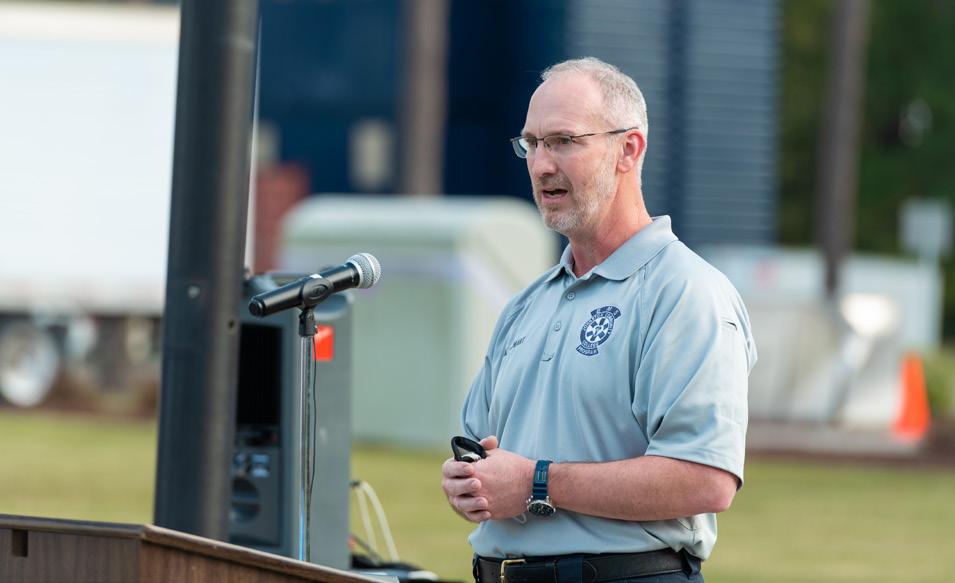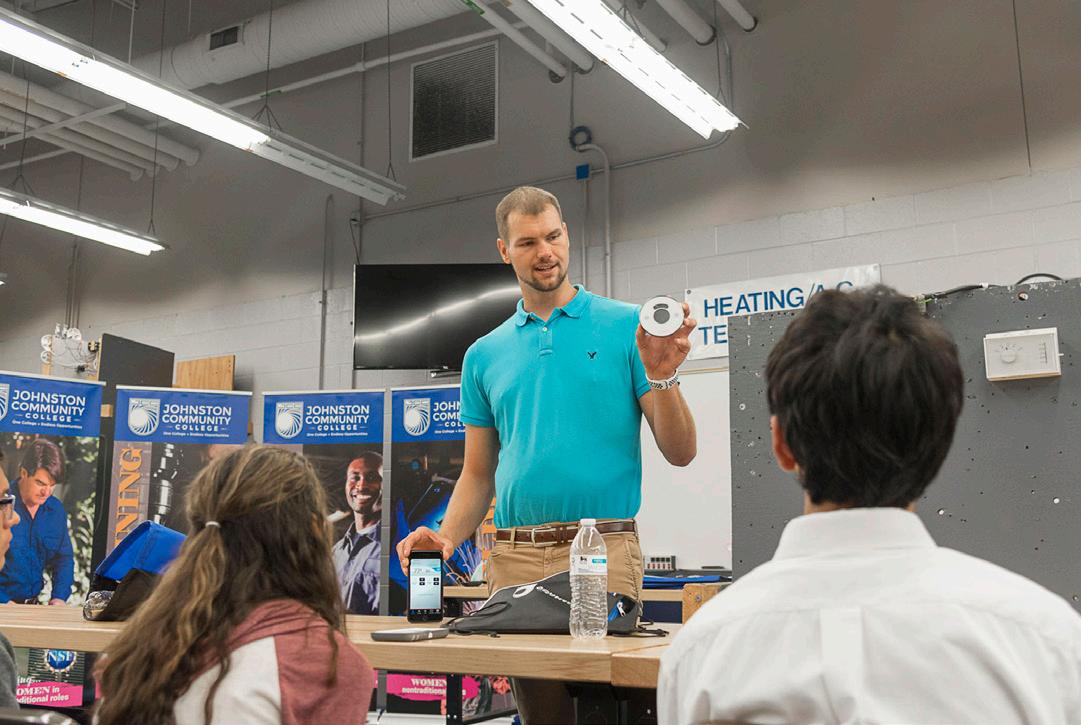STRATEGIC PLAN 2021-2026










The development of the 2021-2026 strategic plan was facilitated by the college’s department of research and institutional effectiveness. The process began in the fall of 2020 with the creation of a draft vision statement by the college’s administrative council and the selection of individuals serving on the strategic planning committee. The strategic planning committee membership was purposefully selected to provide input from all areas and stakeholders of the college. Representatives from all college divisions, students, faculty, trustees, and local business owners were included.
The strategic planning committee held its first meeting on December 10, 2020. During this initial meeting, the committee members were provided an overview of strategic planning and its importance to the college. Additionally, committee members provided input on the mission statement, institutional goals, and a draft vision statement. Committee members reviewed the current mission statement and decided to add the word “equitable” to the college’s current mission statement. Committee members were placed into teams and asked to answer the question, “What does this vision statement mean to you?” The recorder captured the feedback from the teams, and the administrative council reviewed the feedback and edited the vision statement accordingly.
The next meeting was held on January 28, 2021. During this meeting, committee members received the final version of the vision statement and the planning assumptions and trends document compiled by the research and institutional effectiveness department. Committee members were asked to review the data provided as well as any other relevant sources.

At the next meeting on March 4, 2021, committee members were once again placed into teams and asked to conduct a strengths, weaknesses, opportunities, and threats (SWOT) analysis, using the planning assumptions and trends document as one source of information. Teams entered their thoughts into a virtual document and were given time after the meeting to continue adding to the SWOT analysis.
Prior to the next meeting, the department of research and institutional effectiveness produced a summary document condensing all of the SWOT themes. On April 1, 2021, committee members reviewed the SWOT summary document and finalized the SWOT statements. Additionally, the committee members worked in teams to conduct a gap analysis. The gap analysis assessed the gap between the institution’s current status (SWOT analysis) and its desired status (vision). As before, team members entered their thoughts into a virtual document and were given time beyond the meeting to add additional insights.
On May 6, 2021, the strategic planning committee held its fifth meeting. Prior to this meeting, the department of research and institutional effectiveness developed draft strategic goals and objectives based on the emerging themes from the gap analysis. During this meeting, the committee reviewed each statement for relevance and wording.
Before the final meeting on June 3, 2021, the Vice President of Institutional Effectiveness and Strategic Initiatives shared the draft SWOT analysis, goals, and objectives with the full Board of Trustees and all faculty and staff. A survey form was developed to capture feedback on the draft plan from stakeholders. The department of research and institutional effectiveness also developed key performance indicators (KPIs) for each goal of the strategic plan. During the final meeting, the strategic planning committee reviewed the feedback from the campus community and the KPIs.
The 2021-2026 strategic plan was presented to the Board of Trustees on September 2, 2021 and was approved by the board. During the first year of the plan, the college and its board of trustees will be presented with a key performance indicators table with baselines and targets for each measure, as available. Each year of the strategic plan, the table will be updated with new data and presented to appropriate stakeholders.

Susan Austin, English Instructor
Mike Baraldi, Vice President of Finance and Facility Services
Dr. Heather Collins, Department Chair, Academic and Career Readiness
Mary Daughtry, Board of Trustees
Harlan Frye, Associate Vice President of Human Resources
Dr. Pam Harrell, Vice President of Student Services
Alexis Jackson, Student
Dr. David Johnson, President
Shakeeta King, Payroll Manager
Dr. Angelina Knies, Department Chair, Social Sciences, Health & Fitness Sciences, ACA 122, and Transfer Initiatives and Programs
Dr. Terri Lee, Vice President of Institutional Effectiveness and Strategic Initiatives


Nikki Murray, Manager of Auditorium and Auxiliary Services
Jeff Pickering, Associate Vice President of Information Technology/Chief Information Officer
Tiffany Ruiz, Medical Office Administration Instructor
Dr. Linda Smith, Vice President of Instruction
Angela Swank, Associate Vice President, Health, Wellness, and Human Services
Josh Thompson, Board of Trustees
Dr. Twyla Wells, Vice President of Advancement and Community Relations
LaShawndra White, Director of Annual Fund and Advancement Communications
Dr. Jamie Wicker, Associate Vice President, Transportation and Public Safety
Amanda Roberts, Associate Vice President of Research and Institutional Effectiveness
Britney Shawley, Coordinator of Institutional Effectiveness
Jennifer Cable, Administrative Assistant to the Vice President of Institutional Effectiveness and Strategic Initiatives


JCC will be a recognized leader in North Carolina for academic success and workforce development, and will be known as an institution with students, faculty, and staff who value individuals as equally important, offer equitable treatment, and foster a sense of belonging for all partners.
JCC provides accessible, equitable, high quality educational and community enrichment opportunities for the successful development of learners.
1. Ensure student achievement of academic goals, enhanced employment opportunities, or transfer to four‐year colleges.
2. Collaborate with appropriate agencies and groups to meet workforce and community needs.
3. Provide and support personal and cultural enrichment, outreach, and community based programs, activities, and events that reflect the diversity within the community.
4. Provide specialized training to ensure future institutional leadership.
5. Promote and recognize the diversity and achievements of faculty, staff, and students.
6. Create, maintain, and enhance a safe environment conducive to learning.
7. Ensure the efficient, appropriate, and effective use of all available resources.
8. Secure and maintain appropriate technology to support the needs of faculty, staff and students.
9. Secure alternative sources of funding.
10. Ensure high quality and continuous improvement in all programs and services by engaging in strategic planning, assessment, and data-informed decision-making.
Connecting with our students from their first day on campus through graduation.
Objective 1.1: Launch a comprehensive firstyear experience designed to connect students to the college and the campus community.
Objective 1.2: Expand retention strategies.
Objective 1.3: Provide excellent customer service to students from prospect to graduate.


• By spring 2022, a comprehensive first-year experience (FYE) will be designed for students.

• By fall 2022, students will begin participating in first-year experience activities.
• By 2026, 80 percent or more of students who participate in first-year experience activities will agree or strongly agree that FYE helped them connect to the college and campus community.
• By 2026, 60 percent of students will participate in at least one activity during the academic year.
• By 2026, 80 percent of first-time fall credential-seeking students will graduate prior to or enroll in post-secondary education during the subsequent spring term.
• By 2026, 75 percent of first-time fall credential-seeking students will graduate prior to or enroll in post-secondary education during the subsequent fall term.
• By 2026, 65 percent of first-time fall credential-seeking student will graduate, transfer, or be enrolled during the fourth academic year with 42 successfully completed non-developmental hours.
• By 2026, 55 percent of first-time fall associate degree-seeking and transfer pathway students will pass a credit-bearing English course with a “C” or better within their first academic year.
• By 2026, 40 percent of first-time fall associate degree-seeking and transfer pathway students will pass a credit-bearing math course with a “C” or better within their first academic year.
• By fall 2022, a comprehensive customer service training program for faculty and staff will be developed and launched.
• By 2026, 95 percent of students will agree or strongly agree that their instructor was available (via email, office hours and/or online instruction) as outlined in the syllabus.
• By 2026, 95 percent of students will be satisfied or very satisfied with the friendliness and courteousness of staff in the following areas: reception, admissions, counseling services, registrar’s office, financial aid, student success and advising, campus police/security, JOLT, and the cashier’s office.
• By 2026, 95 percent of graduates will indicate yes to the question “Would you recommend JCC to your friends and acquaintances?”
Supporting and entrusting our employees so they experience an inclusive campus culture.
Objective 2.1: Implement an extensive employee onboarding experience that acclimates new employees to JCC policies, procedures, divisional/departmental expectations, and culture.
Objective 2.2: Support a mentoring program for all new college employees and current employees who transition into a new role.
Objective 2.3: Administer a structured professional development program for employees, to include training for newly promoted supervisors.
Objective 2.4: Ensure diversity of ideas and experiences in staff and faculty through effective recruitment strategies and the development of a comprehensive diversity, equity, and inclusion plan.

• By summer 2022, an extensive employee onboarding experience will be developed.

• By fall 2022, 100 percent of new employees will participate in the onboarding experience.
• By 2026, 90 percent of new employees who participate in the onboarding experience will agree or strongly agree that the onboarding experience acclimated them to JCC policies, procedures, divisional/departmental expectations, and culture.
• By 2026, employees will be satisfied or very satisfied with the extent to which administrative processes are clearly defined at a frequency at or above the PACE normative measure.
• By summer 2022, a mentoring program for all new college employees and current employees who transition into a new role will be developed.
• By fall 2022, new employees and current employees transitioning into a new role will participate in a mentoring program.

• By 2026, 90 percent of new employees and employees who transition to a new role who participate in a mentoring program will agree or strongly agree that the mentoring program helped them in their new position.
• By summer 2022, a structured professional development program will be developed.
• By fall 2022, 100 percent of employees will begin participating in a structured professional development program.
• By 2026, 90 percent of employees who participate in a structured professional development program will agree or strongly agree that the professional development program enhanced their job-related skills.
• By 2026, 85 percent of employees will be satisfied or very satisfied with the extent to which professional development and training opportunities are available.
• By fall 2022, a far-reaching diversity, equity, and inclusion plan will be developed.
• By 2026, employees will be satisfied or very satisfied with the extent to which JCC effectively promotes diversity in the workplace at a frequency at or above the PACE normative measure.
• By 2026, employees will be satisfied or very satisfied with the extent to which student diversity is important at JCC at a frequency at or above the PACE normative measure.
• By 2026, employees will be satisfied or very satisfied with the extent to which JCC has a strong commitment to promoting racial/ethnic harmony at a frequency at or above the PACE normative measure.
• By 2026, employees will be satisfied or very satisfied with the extent to which JCC values racial/ethnic diversity at a frequency at or above the PACE normative measure.
• By 2026, employees will be satisfied or very satisfied with the extent to which JCC is accepting of people of different racial/ethnic backgrounds at a frequency at or above the PACE normative measure.
• By 2026, employees will be satisfied or very satisfied with the extent to which JCC employees of different racial/ethnic backgrounds communicate well with one another at a frequency at or above the PACE normative measure.
Ensuring there are no barriers to education through communication and easier processes.
Objective 3.1: Revamp the website for easier navigation, current content, and relevancy to a diverse group of users.
Objective 3.2: Design diverse marketing strategies that promote a positive perception of the college and its programs.
Objective 3.3: Enhance internal communication for both employees and students to promote timely and efficient relay of information.
Objective 3.4: Bolster systems for providing comments and closing feedback loops to ensure all stakeholders have a voice.


• By summer 2023, the JCC website will be revamped for easier navigation, current content, and relevancy to a diverse group of users.
• By 2026, 98 percent of students will agree or strongly agree that the JCC website met their overall need.
• By 2026, 95 percent of students will agree or strongly agree that it was easy to find the information they needed on the JCC website.

• By 2026, 60 percent of employees will be satisfied or very satisfied with the extent to which information is shared within the institution.
• By 2026, 60 percent of employees will be satisfied or very satisfied with the extent to which open and ethical communication is practiced at JCC.
• By 2026, 75 percent of employees will be satisfied or very satisfied with the extent to which they receive adequate information regarding important activities at JCC.
Creating a rich and dynamic curriculum which ensures student success.
Objective 4.1: Create relevant and current programs and courses to meet student and stakeholder needs.
Objective 4.2: Facilitate the expansion efforts into Clayton.
Objective 4.3: Analyze performance metrics in order to adjust instruction and services to improve student success and close achievement gaps.


• By 2026, total annual headcount (both curriculum and continuing education) will increase by 10 percent to 13,720.
• By 2026, actual FTE (both curriculum and continuing education) will increase by 10 percent to 4,636.
• By 2026, JCC associate degree graduate employment rates one year after completion will meet or exceed the NCCCS overall rate.
• By 2026, JCC associate degree graduate median annual earnings one year after completion will meet or exceed the NCCCS overall rate.
• By summer 2022, land will be secured in western Johnston County for a new campus.
• By spring 2024, architectural plans will be developed for a new campus in western Johnston County.
• By spring 2026, construction will begin on a new campus in western Johnston County.
• By 2026, JCC will meet or exceed benchmarks for all North Carolina Community College System State Performance Measures.

Reinforcing our foundation so Johnston Community College can grow and meet the needs of the community.
Objective 5.1: Implement a plan of action to invest in JCC’s assets (equipment, technology, facilities, and personnel).
Objective 5.2: Establish procedures for equitable funding in all areas while aligning funding with institutional priorities.
Objective 5.3: Institute fundraising strategies for innovative need areas.
Key Performance Indicators (KPIs)

• By fall 2022, a plan of action to invest in JCC’s assets will be developed.
• By fall 2022, procedures for equitable funding in all areas while aligning with institutional priorities will be established.
• By fall 2022, fundraising strategies for innovative need areas will be developed.

• By 2022, initial bond referendum for new campus in western Johnston County will be launched.
• By 2024, second bond referendum for new campus in western Johnston County will be launched.
• By 2026, annual performance-based funding will increase by 10 percent to $619,559.

• By 2024, current annual giving will increase by 15 percent to $1,571,425 annually.
• By 2026, total endowment size will increase by 20 percent to $8,621,052.
• By 2026, annual county appropriations will increase by 10 percent to $5,971,824.
S trengths, W eaknesses, O pportunities and T hreats (SWOT)
Harmful to achieving goals
Helpful to achieving goals
1. Insufficient funding has led to issues with replacing outdated equipment, providing comprehensive employee professional development, and maintaining and renovating facilities.
The process to move from a prospective student to an enrolled student can be difficult for students and parents to navigate.
to students is confusing at times.
Current marketing efforts are not competitive with those of surrounding community colleges.
levels in some areas are not adequate.
Recruiting efforts fail to adequately attract diverse candidates.
2.
As one of the 58 community colleges in the North Carolina Community College System, Johnston Community College (JCC) offers affordable in-state tuition as compared to the national average.
1.
6.
7. Onboarding
Hours of employee availability are inadequate for students requiring non-traditional meeting times.
8.
Processes for identifying and intervening with at-risk students can be improved.
9.
attrition hampers effective and efficient delivery of programs and services.

11. Employee
12. The campus does not have enough spaces or experiences for students and the community to socialize and engage with each other.
13. The
15. Departments differ in their levels of embracing technology.
16. From 2019 to 2020, the college declined on four of seven state performance measures.
The Student Success Center shines as a one-stop shop for front-door and onboarding experiences for students. 3. The Strategic Enrollment Management Team excels in its purpose to attract, retain, and graduate students.
According to annual Integrated Postsecondary Education Data System (IPEDS) reporting, average faculty salaries have been the highest in the state for the past several years.
2.
4.
5. Staff and faculty are resilient in the face of adversity, flexible to change, caring and student-focused, and well qualified in their areas.
In addition to regional accreditation by the Southern Association of Colleges and Schools Commission on Colleges (SACSCOC), the college holds over 20 national and state optional programmatic accreditations.
6.
The award-winning One College model strives to eliminate silos and foster the best environment for student success.
7.
The college offers a breadth of programs for a wide range of student interests.
8.
(attributes of the organization)
The senior leadership is engaged in the activities of the college and approachable to employees, students, and the community.
9.
10. Over the years, JCC has nurtured strong community, industry, and university partnerships, resulting in a positive reputation in the county and the state.
Faculty and staff work well together in a family-like atmosphere.
11.
12. Private giving cultivated by the JCC Foundation has led to healthy endowments for scholarships and institutional support.
13. Graduates and completers enjoy a high level of success on licensure exams, transfer performance, and employment attainment.
Harmful to achieving goals

Community colleges continue to be perceived as inferior to four-year institutions.
Career and College Promise is a legislatively mandated dual enrollment initiative and could be impacted by changing governmental leadership.
North Carolina community colleges, undocumented immigrants are required to pay the out-of-state tuition rate.
about 30 years, North Carolina has allocated state funds to community colleges based on a funding-in-arrears model.
Cybersecurity incidents are on the rise nationally. Just within the past three years, several North Carolina community colleges have been victims of a cyber crime.
Global pandemics are a reality.
Helpful to achieving goals
Threats
1.
5.
6.
Opportunities
Johnston County is one of the fastest growing counties in the state.
1.
2.
Johnston County is adjacent to the largest urban center in the state, is located at the crossroads of Interstate 95 and future Interstate 42 (Highway 70), and will soon include the outer loop of the Beltline (I540). 3. The main campus has land for expansion of facilities.
Nationally, dual enrollment agreements between community colleges and four-year universities are on the rise.
4.
Post-COVID, more students will arrive at the college prepared to learn in a variety of virtual environments (synchronous, asynchronous, hybrid) and will expect more programs and services to be offered 100% online.
5.
Due to COVID, institutions across the nation are experiencing significant enrollment declines.
The increase in virtual offerings due to COVID escalates competition across all 58 North Carolina community colleges and beyond.
Mental health issues continue to rise, even more so due to the after effects of COVID.
7.
8.
9.
10. The county’s low unemployment rate makes the college ineligible for certain grant programs.
There are 40 post-secondary educational institutions within 45 miles of Johnston Community College.
11.
12. Local business and industry can offer more competitive salaries than the college in most fields. 13. One of the largest obstacles to college success is student financial insecurity.
Johnston County Economic Development works to attract a diverse industry presence in the county.
6.
The Paul A. Johnston Auditorium is set to reopen soon.
7.
Pell grants are now available to incarcerated persons.
8.
Local industries, education, and government partners continue to develop and expand JOCO Works.
9.
10. Construction of the Engineering building, which will provide increased capacity for STEM opportunities, has begun.
(attributes of the environment)
Recent social movements have brought national attention to diversity, equity, and inclusion issues.
11.
12. There are several military installations in close geographic proximity to JCC.
13. COVID is prompting more underemployed and unemployed workers to seek higher education, and community colleges excel at career-oriented programming.
14. Johnston County Public Schools (JCPS) has grown by 12% in enrollment within the last decade; 30% within the last 15 years.
Hispanic students currently make up 27% of JCPS enrollment. Five years ago that percentage was 22%, a decade ago it was 17%, and fifteen years ago it was 13%.
15.
Prior to the strengths, weaknesses, opportunities, and threats (SWOT) analysis, the strategic planning committee received a planning assumptions and trends document. Information within the document was researched and compiled during the fall semester 2020 by an environmental scanning team comprised of Dr. Terri Lee (Vice President of Institutional Effectiveness and Strategic Initiatives), Amanda Roberts (Associate Vice President of Research and Institutional Effectiveness), and Britney Shawley (Coordinator of Institutional Effectiveness). The information was organized in the following categories: historical, sociocultural, county-related, educational, economic, legal, natural/physical resources, and instructional technology. Some data highlights from the document are included below:
Johnston County NC Top 25 Employers (2019)
3. Grifols Therapeutics Inc. (1000+ Employees)
6. Asplundh Tree Expert Co Inc (1000+ Employees)
9. Caterpillar, Inc (500-999 Employees)
12. Sysco Raleigh, LLC (250-499 Employees)
15. McDonald’s (250-499 Employees)
18. Executive Personnel Group LLC (250-499 Employees)
20. 3C Packaging, Inc. (250-499 Employees)
23. Department of Public Safety (100-249 Employees)
21. Principle Long Term Care Inc. (100-249 Employees)
24. Pgi/Chicopee Inc. (100-249 Employees)

We value continuous growth and improvement in every area of campus life. We will strive to provide adequate resources so that, over time, such improvement can be seen and measured.
We value teamwork, cooperation, collaboration, innovation, and creative problem solving as part of our continuous improvement efforts.
We value freedom to instruct students using various techniques and to develop methods that will help them achieve their maximum potential.
We value the courage to provide leadership, to take risks, to welcome change and to persevere.
We value honesty and integrity and believe that academic and personal honesty are essential elements in education.
We believe that integrity binds us to fairness, to truth, and to actions and philosophies that meet the highest ethical standards.
We value intellectual honesty and academic freedom and pledge to foster an environment of trust and responsibility in the learning community.
Community
We value prompt, fair, friendly, courteous, and people-centered service to our communities and to each other.
We value the many opportunities we have to help make our community, state, nation, and world a better place to live.
We value learning as a lifetime endeavor.
We value the input of learners as we assist them in achieving their goals.
We create a nexus for learning in this community to include meeting the changing needs of the learner.
We value our faculty, administration, support staff, and maintenance and operations personnel. We respect their diverse life experiences, appreciate their contributions to our learning community, and encourage their individual, personal, and professional development.
We believe that all people should be treated with respect, creating a safe, inclusive, and nurturing environment that supports a balanced lifestyle as well as opportunities for life-long learning.
Communication
We value open and honest dialogue, feedback, and active listening, flowing in all directions.


We value team spirit, whereby each member operates unselfishly for the benefit of the cause.
Johnston Community College is accredited by the Southern Association of Colleges and Schools Commission on Colleges to award the associate degree. Contact the Commission on Colleges at 1866 Southern Lane, Decatur, Georgia 30033-4097 or call (404) 679-4500 for questions about the accreditation of Johnston Community College.
Johnston Community College is an equal educational and employment opportunity institution and does not discriminate on the basis of race, color, national origin, sex, sexual orientation, gender, gender identity, gender expression, pregnancy, disability, age, religion, veteran status, or any other characteristic or status protected by applicable local, state, or federal law in admission, treatment, or access to, or employment in, its programs and activities. All inquiries regarding compliance with access, equal opportunity, Title IX, and/or grievance procedures should be directed to the Associate Vice President of Human Resources, 245 College Road, Wilson Building, Smithfield, NC 27577 or via telephone at (919) 209-2025 or the Vice President of Student Services, 245 College Road, Wilson Building, Smithfield, NC 27577 or via telephone at (919) 209-2048.

